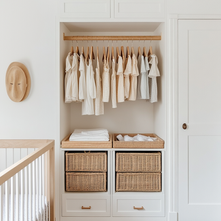How to Master Room Layouts Like a Pro: A Step-by-Step Guide
- Beril Yilmaz

- Jan 3
- 6 min read
Designing your home involves much more than just aesthetics; the arrangement of furniture and decor can significantly influence the overall atmosphere and functionality of any space. Whether you're working with a snug living room, an expansive bedroom, or a compact dining area, mastering the art of room layout is essential. Effective layout techniques can turn your environment into a cozy haven that showcases your personal style while meeting daily needs.
In this guide, we will share proven strategies and practical tips that empower you to redesign your spaces like a professional interior designer. From visualizing the layout and optimizing flow to taking accurate measurements and focusing on key features, we provide the insights necessary to enhance any room. By the end of this post, you'll know how to effectively blend aesthetics with functionality in your home.
Let’s get started on creating efficient room layouts to ensure every space feels warm and personalized.
1. How to Room Lay Out: The Foundation of Your Design

Before rearranging furniture, it's crucial to lay down a solid foundation for your room layout. Start by identifying the primary purpose of the room. Are you crafting a peaceful bedroom, a lively family room, or a productive home office? Understanding the room’s main function helps shape your design choices.
Take inventory of your current space. Examine your furniture, decor, and existing layout. Identify pieces you cherish, items you might discard, and any new additions you need. For example, if your living room feels cramped but you love your sectional sofa, consider rethinking your coffee table size or relocating accent chairs. Gathering inspiration from design blogs, magazines, or social media can help. Create a mood board with images that inspire you while ensuring to incorporate your personal styles for a touch of familiarity.
2. How to Room Lay Out: Measure Your Space

Understanding your room's dimensions is one of the most critical aspects of layout design. Begin by measuring the total area, noting wall lengths, and the positions of doors and windows. This will help in establishing clear pathways and functional zones.
After gathering your measurements, create a scaled floor plan using graph paper or digital tools. Mark the locations of electrical outlets and light fixtures, as they will play a pivotal role in your furniture arrangement. For reference, a standard living room might be around 250 square feet, requiring careful planning of furniture placement to avoid clutter.
When measuring your furniture, consider its height, width, and depth. For example, if you have a coffee table that is 30 inches wide, make sure its placement allows for at least 36 inches of space for movement. This attention to detail fosters an open atmosphere.
3. How to Room Lay Out: Create Zones

Defining zones within a room is essential for optimal layout and function. In multifunctional areas, like a family room that also serves as an office, zoning creates boundaries, making it easier to engage in different activities.
To establish these zones, arrange furniture to define areas while maintaining a smooth flow. For instance, position a sofa and chairs around a coffee table to foster conversation, while a side table can indicate a workspace. Consider using rugs, lighting, or subtle color differences to visually distinguish each zone. Avoid overwhelming the space with too much separation; seamless transitions are key.
Moreover, ensure each zone is accessible from others, keeping pathways clear and allowing free movement. Thoughtful zoning maximizes your space's usability, making it inviting and practical.
4. How to Room Lay Out: Focus on Focal Points

A focal point is the standout feature in a room that captures attention and creates visual interest. This could be a beautiful fireplace, an eye-catching piece of art, or even a stunning window view. Once you identify the focal point, arrange your furniture and decor to enhance it.
For example, in a room with a fireplace, place seating around it to encourage conversation and enjoy its warmth. If a window offers a breathtaking view, position a comfortable chair and side table nearby for reading or relaxing.
While highlighting your focal point, avoid crowding it with unnecessary decor. Instead, surround it with complementary pieces that enhance its features and contribute to the overall ambiance.
5. How to Room Lay Out: Consider Traffic Flow

Traffic flow is essential for a functional room layout. It involves considering how people move through a space. A well-designed layout ensures these paths are clear and logical.
Think about common pathways in the room. For example, the route from the entrance to the seating area or between zones should remain unobstructed. Keep large furniture pieces out of high-traffic areas. If your living room has a large sectional sofa, position it to keep access points clear, allowing guests to move comfortably around the space.
When arranging furniture, ensure that seating is placed to encourage conversation without disrupting flow. Remember, inviting spaces foster warmth and connection.
6. How to Room Lay Out: Utilize Vertical Space

When planning a room's layout, don’t forget about vertical space. Making use of wall area can dramatically improve the room's function and design.
Consider adding tall bookshelves, wall-mounted shelves, or cabinets to draw the eye upward. This creates a sense of spaciousness while providing ample storage. For instance, using vertical shelving can help maximize your storage options in a small living room, allowing you to keep the floor clear and open.
Incorporate artwork, mirrors, or plants at different heights to create a dynamic visual interest. These elements not only enhance the room’s aesthetic but also create a feeling of openness.
7. How to Room Lay Out: Add Personal Touches

With the functional layout established, it's time to add your personal touches. These elements transform a space from generic to truly yours. This could involve displaying family photos, cherished artwork, or meaningful collectibles.
As you introduce these personal elements, pay attention to the balance of color and texture. This cohesion will prevent the room from feeling cluttered. For example, if you opt for a bold area rug, coordinate the colors in your cushions and artwork to create harmony rather than chaos.
Textiles such as cushions, throws, and area rugs can enhance comfort while reinforcing your desired aesthetic. Let your individuality shine through, ensuring the space feels like home.
8. How to Room Lay Out: Evaluate and Adjust

After establishing your layout, it’s vital to assess and adjust as needed. Spend time in the space, observing how it feels during different activities. Take note of any areas that require improvement.
For example, if you find that seating is insufficient when entertaining, consider rearranging or adding more chairs. Identify any furniture causing flow disruptions or underutilized spaces that could serve a better purpose.
Room layouts aren’t a static project; they can and should evolve. By remaining open to adjustments, you can adapt your space to meet changing needs or preferences.
Final Tips
Mastering room layout is a fulfilling process that can bring remarkable benefits. By understanding and applying the principles outlined in this guide, you can significantly enhance both the look and function of your home.
From measuring and zoning to focusing on focal points and analyzing traffic flow, every decision contributes to a space that is not only visually appealing but also aligned with your lifestyle. The ultimate aim is to craft a harmonious environment that embodies your identity while accommodating your daily routines.
As you embark on your next design endeavor, embrace these strategies, explore your creativity, and allow your home to be a true reflection of you.
FAQs
Q1: What is the first step in designing a room layout?
Identifying the purpose of the room is the first step. Understanding how you plan to use the space will inform your design decisions.
Q2: How can I ensure my room feels spacious?
To make a room feel larger, avoid overcrowding with furniture. Use light colors, reflective surfaces like mirrors, and elements that draw the eye upward.
Q3: How often should I redesign my room layout?
You can redesign your layout whenever your needs change—whether due to lifestyle shifts, new furniture, or the desire for a fresh look.
Q4: How can I make my room layout more functional?
To enhance functionality, assess traffic flow, define zones, and ensure furniture serves its purpose without cluttering the space.
Ready to transform your space into a beautifully designed haven? At BY Design And Viz, we specialize in creating stunning interiors that reflect your unique taste and lifestyle. Contact us today to schedule a consultation and get started on your next design project!


































